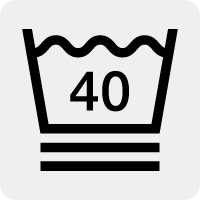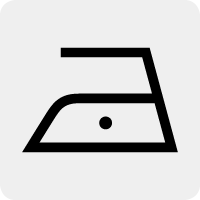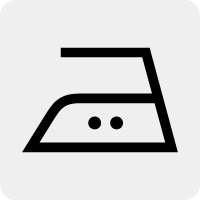How to read garments care labels
Discover how to take better care of your garments
Why is it so important to check your garments' labels?

Care labels are probably the least visible and smallest elements in garments, yet they can undoubtedly be considered as one of the most important tools that consumers have at their disposal. The correctness of the information and the clarity of the contents are the first indicators of the manufacturer’s seriousness and, therefore, the reliability of the purchased product. In fact, In addition to the brand name and size, there can be a lot of other fundamental information about the garment; in particular where it was produced, which materials it is made of and the care instructions, which provide information, for consumers as well as professionals cleaners, on the maximum permitted treatment and on the proper care of textiles.
There are 5 groups of care symbols
Nr. 1
Washing symbols
These symbols tell whether domestic washing is possible or not and applies both to hand and machine washes. The numbers in the wash tub specify the maximum washing temperatures, while the bars below the wash tub identify the strenght of washing cycles ( no bar= easy care; 1 bar= mild wash; 2 bars= very mild wash
Nr. 2
Drying symbols
These symbols tell you the way your garment should be dried: tumble drying or natural drying? While the square frame is the general symbol for drying, the circle in the square is a reference to tumble drying. The dots in the dryer drum indicate the temperature and strenght to be used. The symbol containing horizontal or vertical line(s) in the square indicate the natural drying process. The Oblique line symbolizes the respective natural drying process to be carried out in the shade.
Nr. 3
Ironing symbols
These symbols tell you wether you can iron your garment or not, and which is the temperature to do it. The dots indicate the temperature ranges for ironing (regulator, steam, travel irons and ironing machines). The maximum temperature must be selected solely on the basis of the care label and not according to the fibre content of a textile article.
Nr. 4
Professional care symbols
These symbols give information on the possibility of professional dry- or wet-cleaning. The circle symbolizes the dry-cleaning and wet-cleaning process for textile articles carried out by professionals.
Nr. 5
Bleaching symbols
These symbols tell whether the article may or may not be bleached.

Washing symbols

Do not wash
Articles marked in this way must not be washed. They may be sensitive to any kind of wet treatment or be unsuitable for washing in a domestic washing machine because of their size.

Hand wash
Hand wash at a water temperature between 30° C and a maximum of 40° C, depending on the particular article. First dissolve a fine detergent in plenty of water. Allow the textiles to float in the solution and agitate carefully. Do not rub, pull and wring out. Then rinse the textiles well, press the superfluous water out carefully and pull into shape. Treat coloured and sensitive pieces rapidly and do not leave lying in the wet state.

30°C very mild fine wash
Articles made, e.g. of machine-washable wool. This washing cycle ensures a much reduced mechanical treatment. Select an appropriate washing program. Reduce the quantity of laundry substantially.

30°C mild fine wash
For articles, e.g. in modal, viscose, polyacryl, polyester and polyamide. Reduce the quantity of laundry. Select an appropriate washing program. Avoid spinning or do spin for short periods only to minimise the risk of creasing.

30°C fine wash
Washing cycle, e.g. for dark coloured articles in cotton, polyester, mixed fabrics etc. Select an appropriate washing program.

40°C very mild wash
For articles e.g. in machine-washable wool. This washing cycle ensures a much reduced mechanical treatment. Reduce the quantity of laundry substantially. The drum should be not more than on-third full. Select an appropriate washing program.

40°C mild wash
Fine laundry, e.g. in modal, viscose, synthetic fibres (polyacryl, polyester and polyamide). Reduce the quantity of laundry. Select a suitable washing program. Prewash only heavily soiled textiles. Avoid spinning or do spin for short periods only to minimise the risk of creasing.

40°C coloured wash
Washing cycle e.g. for dark coloured articles made of cotton, polyester, mixed fabrics etc.

60°C coloured wash
“Easy care” coloured wash: reduce the quantity of laundry. The drum must not be more than two-thirds full. Set the appropriate washing program (careful wash). Prewash only if the textiles are heavily soiled. Avoid spinning or do spin for short periods only to minimise the risk of creasing.

60°C coloured wash
Coloured articles which must not be washed at boiling temperature e.g. made of cotton, modal, polyester and mixed fabrics.

95°C boil wash
Articles e.g. in cotton or linen, white, suitable for boiling, dyed or printed. Fill the drum completely. Set an appropriate washing program (normal washing cycle). Pretreat stubborn stains.
Drying symbols

Drip flat drying in the shade
e.g. woolen jackets

Drip line drying in the shade
e.g. delicate textiles like silk

Flat drying in the shade
e.g. woolen or delicate textiles

Drip flat drying
e.g. colourfast but delicate textiles

Line drying in the shade
e.g. textiles which are not colourfast (silk)

Flat drying
e.g. heavy, colourfast textiles

Line drying
e.g. all colourfast textiles

Drip line drying
e.g. colourfast, large textiles to dry them without wrinkles.

Normal drying process
Drying in the tumbler is possible under normal load and temperature (80°) without limitations.

Mild drying processes
Caution is appropriate when tumble drying. Select mild process with reduced thermal action (temperature, duration of treatment).

Do not tumble dry
Articles unsuitable for tumble drying.
Ironing symbols

Do not iron
Irreversible changes must be expected if an iron is used.

Iron at low temperature
Iron at maximum sole plate temperature of 110 °C. Corresponding to the “Polyacryl, polyamide (nylon), acetate” setting: if necessary, shiny or pressure-sensitive pieces should be ironed with a press cloth or inside out. Caution when using steam irons (as a rule, work without steam).

Iron at moderate temperature
Iron at maximum sole plate temperature of 150 °C. Corresponding to the “wool/silk/polyester/viscose” setting: iron under a moderately moist intermediate cloth. A steam iron can be used. Avoid heavy pressure.

Hot Iron
Iron at maximum sole plate temperature of 200 °C. Corresponding to the “Cotton/linen” setting; iron whilst damp; treat and if necessary moisten; shiny or pressure-sensitive pieces should be ironed with press cloth or ironed inside out. A steam iron may be used.
Professional care symbols

Do not wet-clean
No professional wet-cleaning allowed.

Very mild professional wet-cleaning
Wet cleaning techniques for very sensitive textiles with much reduced mechanical action.

Mild professional wet-cleaning
Wet cleaning technique for sensitive textiles with reduced mechanical action.

Professional wet-cleaning
Normal wet cleaning methods with no restrictions.

Do not dry-clean
No professional dry-cleaning allowed. Do not use stain removers which contain solvents.

Professional dry-cleaning in: hydrocarbons (heavy benzines)
Mild cleaning process with stringent limitation of added humidity and/or mechanical action and/or temperature. Commercial stain removers on a solvent base may not be used.

Professional dry-cleaning in: hydrocarbons (heavy benzines)
Normal cleaning process with no limitations. Commercial stain removers on a solvent base may not be used.

Professional dry-cleaning in: perchloroethylene, hydrocarbons (heavy benzines)
Mild cleaning process with stringent limitation of added humidity and/or mechanical action and/or temperature. Commercial stain removers on a solvent base may be used with some restrictions. A trial on a concealed part of the article is advisable beforehand.

Professional dry-cleaning in: perchloroethylene, hydrocarbons (heavy benzines)
Normal cleaning process with no restrictions. Commercial stain removers on a solvent base may be used with some restrictions. A trial on a concealed part of the article is advisable beforehand.
Bleaching symbols

Only oxygen bleach allowed
The triangle with two oblique lines indicates that oxygen bleach (contained in universal detergents) is permitted but not chlorine bleach.

Any bleach allowed
The empty triangle is the symbol for chlorine and oxygen bleach.

Do not bleach
The triangle with a diagonal cross (St. Andrews Cross) indicates that bleaching is not allowed. Use only bleach-free detergent.
About Manteco, Italian premium textiles and circularity since 1943
After decades in the fashion world, in 2018, we have created the Manteco Academy project, through which we give webinars, in-person lessons and workshops on eco-design, circular economy and sustainability to numerous fashion schools, technical universities and brands worldwide. Thanks to this educative commitment and our heritage, we are often invited as guest speaker at events, panels, podcasts and conferences about sustainable fashion and circular economy.

